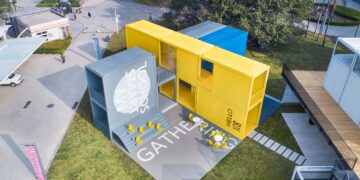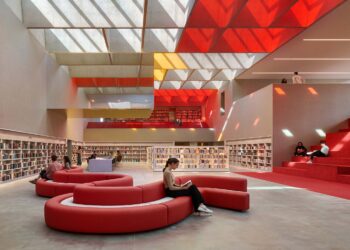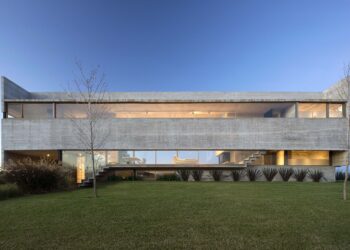A hidden retreat immersed in the Mexican forest
멕시코 숲에 묻혀 숨겨진 별장
Francisco Pardo Arquitecto | 프란시스코 파르도 아키텍토

Casa Aguacates — Avocado House was conceived for a young couple and their child as a weekend retreat, is located two hours from Mexico City, in the rural lake area of Valle del Bravo.
The area enjoys pleasant weather all year round as well as panoramic views; the three-hectare site, nestled in a valley between the mountains, is covered by an avocado field that slopes down into a dense forest, hence the name of the house.
까사 아구아카테스, 즉 아보카도 하우스는 젊은 커플과 자녀를 위한 주말 별장으로 구상되었다. 멕시코 시티에서 2시간 떨어진 바예 드 브라보의 시골 호수 지대에 위치한다.
이 지역은 일 년 내내 쾌적한 날씨와 전경을 즐길 수 있다. 산 가운데 골짜기에 자리한 3헥타르의 부지는 아보카도 숲으로 덮여 있고 내리막길을 지나면 빽빽한 숲으로 이어진다. 집의 이름도 여기서 연유했다.




“The main goal was to guarantee a view of the forest, but at the same time, to leave the avocado field intact, which inspired us to literally bury the house”, explained founding partner Francisco Pardo.
The concept revolves around minimizing impact on the surroundings. Avocado trees sprout above the concealed and unassuming structure, which overlooks the treetops of the forest. As keen hang gliders, the couple had a special interest in what they deemed the “fifth façade” — the view from the sky – which is designed as meticulously as its counterparts, to help the house naturally blend into the context.
This solution also provides optimal internal thermal conditions, in an area affected by considerable temperature variation between night and day, as the earth above the roof keeps the house at a constantly mild temperature.
Inside, the sunken volume unfolds with a simple open layout, where partition walls are low and isolated from the roof in order to create a continuous concrete ceiling running through the whole plan. A big open space features a kitchen, dining room, and living room, with few custom designed elements such as the kitchen island and a black metal fireplace punctuating the space. Four bedrooms and a studio are accommodated around this space.
The back area, pierced to become an interior patio, provides a second source of sunlight and ventilation.




“주된 목표는 숲의 경관을 보장하고 동시에 아보카도 숲을 건드리지 않는 것이어서, 우리는 말 그대로 집을 땅 속에 숨기자는 생각을 했다”고 설립 파트너 프란시스코 빠르도가 설명했다.
집의 컨셉은 주변 환경에 미치는 영향을 최소화하는 걸 중심으로 했다. 아보카도 나무들은 가려져 있어 나서지 않는 구조들 위로 자라나며, 숲 꼭대기를 내려다본다. 열정적인 행글라이더이기도 한 이 커플은 그들이 “건물의 다섯번 째 앞면”이라 여기는, 하늘에서 내려다본 뷰에 특별한 관심을 가졌다. 이는 다른 부분들만큼이나 꼼꼼하게 디자인되어 집이 주변 환경에 자연스럽게 섞일 수 있게 했다.
이 해결책은 집의 실내열 환경 역시 최적화했다. 이 지역은 낮과 밤 간 상당한 일교차의 영향을 받지만, 지붕 위에 위치한 땅이 계속해서 포근한 온도를 유지시켜준다.
묻혀 있는 내부 면적은 심플한 오픈 레이아웃으로, 파티션 벽들은 낮고 지붕에서 따로 떨어져 있어 콘크리트 천장이 끊어짐 없이 전체 면적을 덮고 있다. 넓은 오픈 스페이스에는 주방, 다이닝룸, 거실, 그리고 커스텀 디자인 요소들인 키친 아일랜드, 그리고 이 공간에 방점을 찍는 블랙 메탈 벽난로 등이 있다. 4개의 침실과 스튜디오가 이를 둘러싸고 있다.




A simple tone and texture palette material selection contributes to the minimal aesthetic and ensures low maintenance considering the property’s function as a weekend home. The walls are coated in Chukum, a natural Yucatan stucco, and partitions are of pine wood recycled from the construction process. A sustainably-sourced cabin serves as a storage room or lookout point, boasting panoramic views of the surroundings, built above the house in leftover wood from the casting.
Ultimately the house aims to represent a symbiosis between architecture and nature, wildness and domesticity.
심플한 톤과 텍스쳐 팔레트, 자재 선정으로 미니멀리즘 미학을 보여주고, 주말 별장이라는 집의 기능을 고려해 적은 유지비를 보장했다. 벽은 천연 유카탄 벽토인 추쿰으로 덮었고, 파티션은 건축 과정에서의 소나무 재목을 재활용했다. 집 위에 캐스팅 후 남은 목재를 활용해 지속 가능한 자재들로 만든 오두막은 창고와 전망대로 기능하며, 주변 환경의 전경을 자랑한다.
궁극적으로 이 집은 건축과 자연, 야생과 가정의 공생을 표현하는 걸 목표로 한다.







Project: Casa Aguacates (Avocado House) / Location: Valle de Bravo, México / Architect: Francisco Pardo Arquitecto / Project team: Francisco Pardo, Wilfrido Estrada, Karen Burkart, Rosa Medrano, Catalina Lombardo, Joanne Elliott, Nayeli Mendez, Ivan Saucedo, Julián Román Ramirez, Renato Torres / Structural engineer: Luis David Moctezuma / Electrical installation: Alejandro Moctezuma, Banah de México / Gross floor area: 246m² / Completion: 2021




































